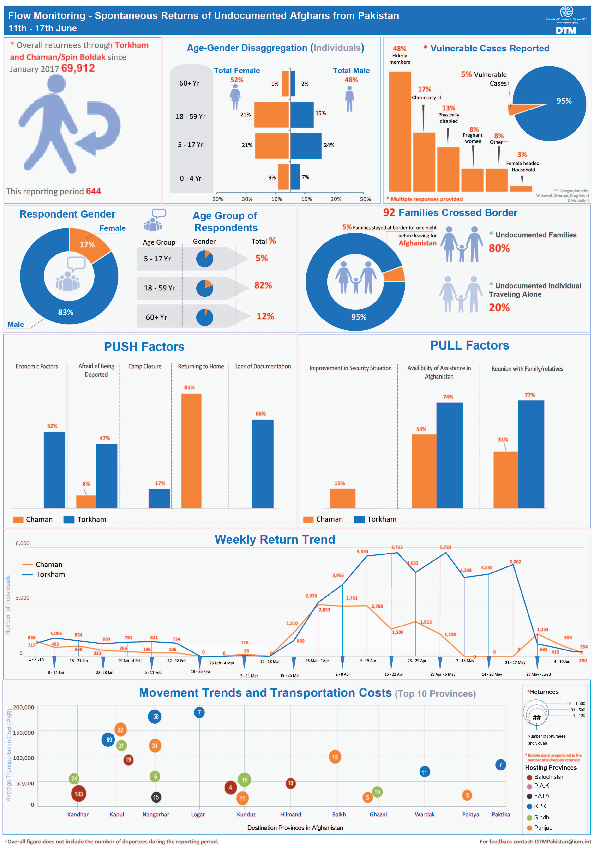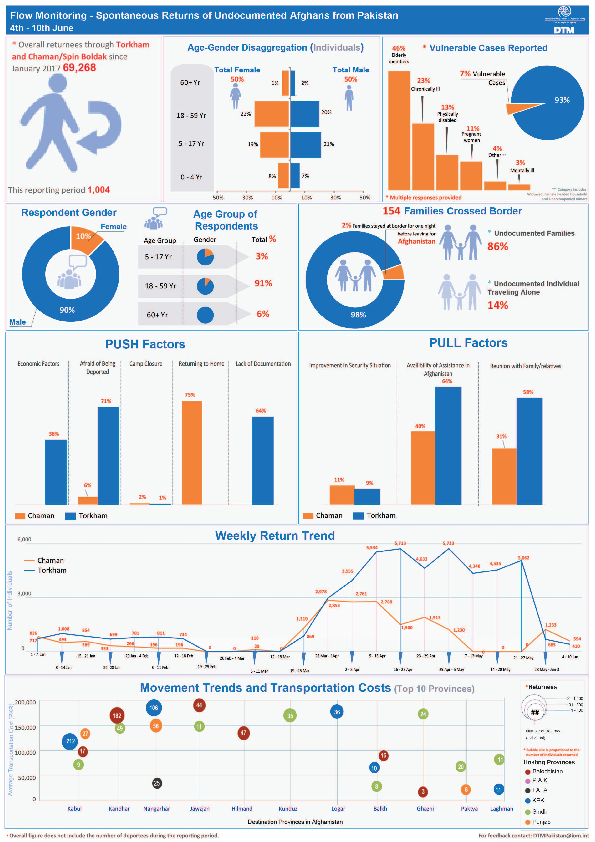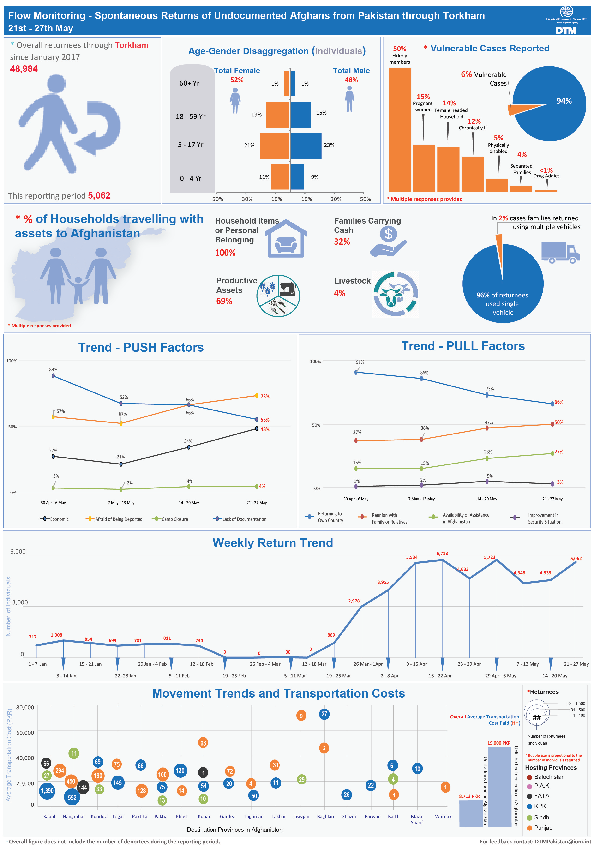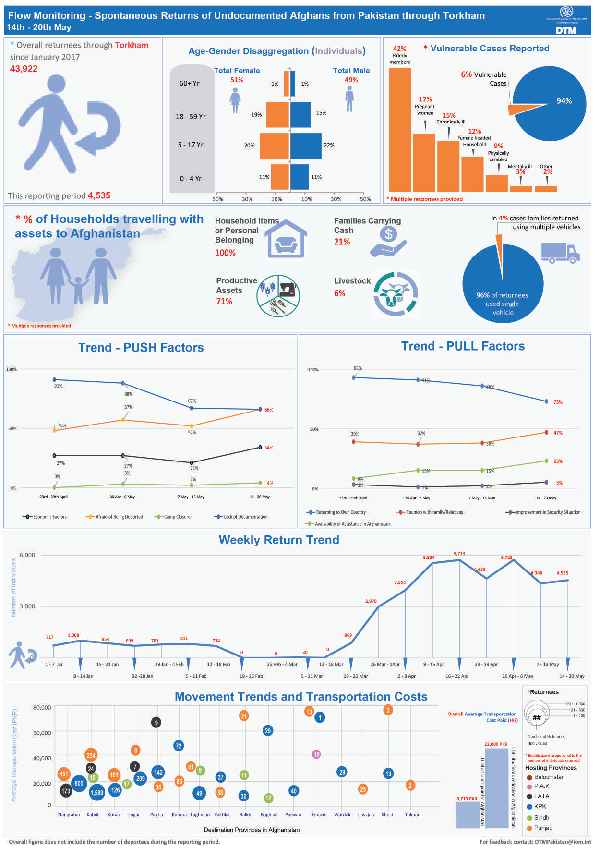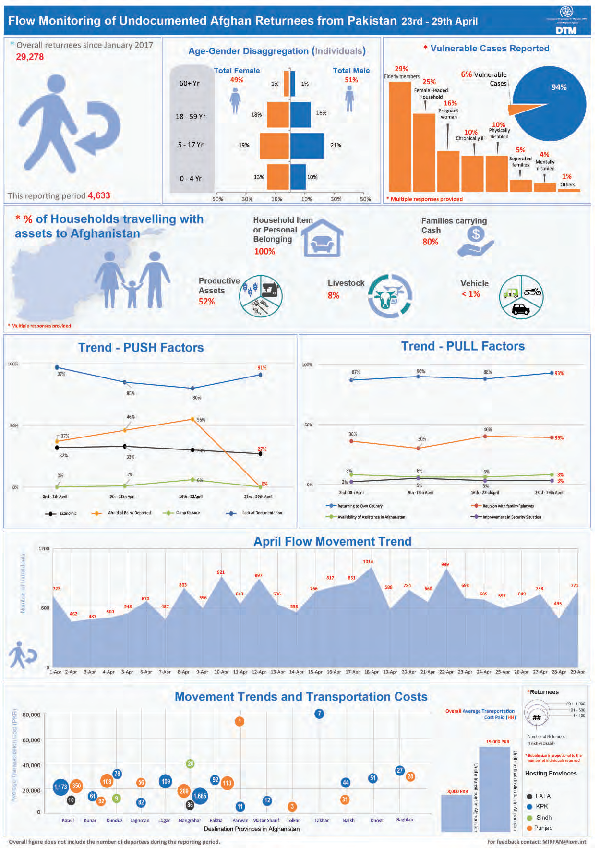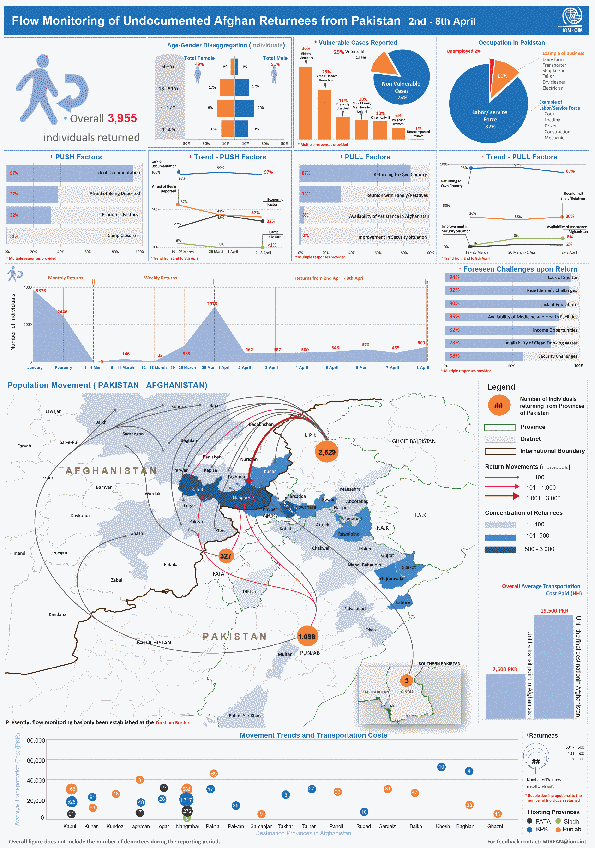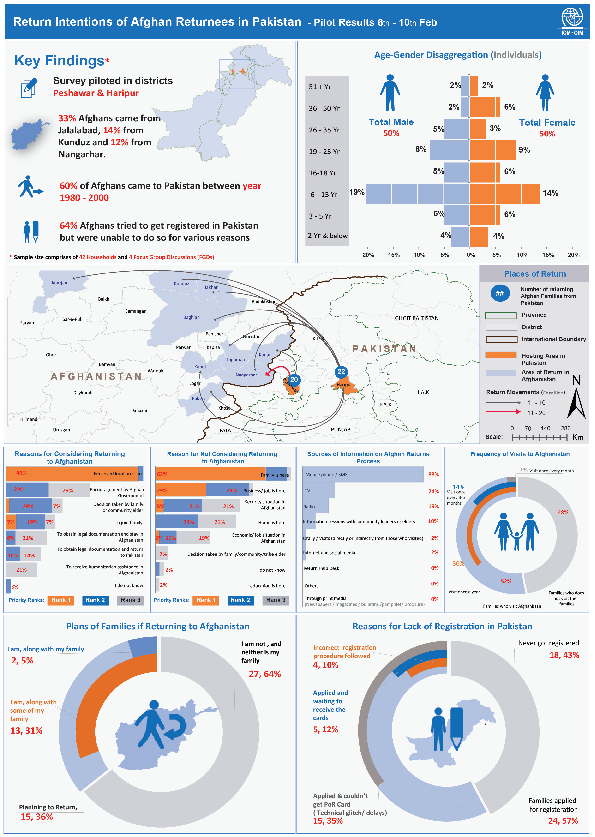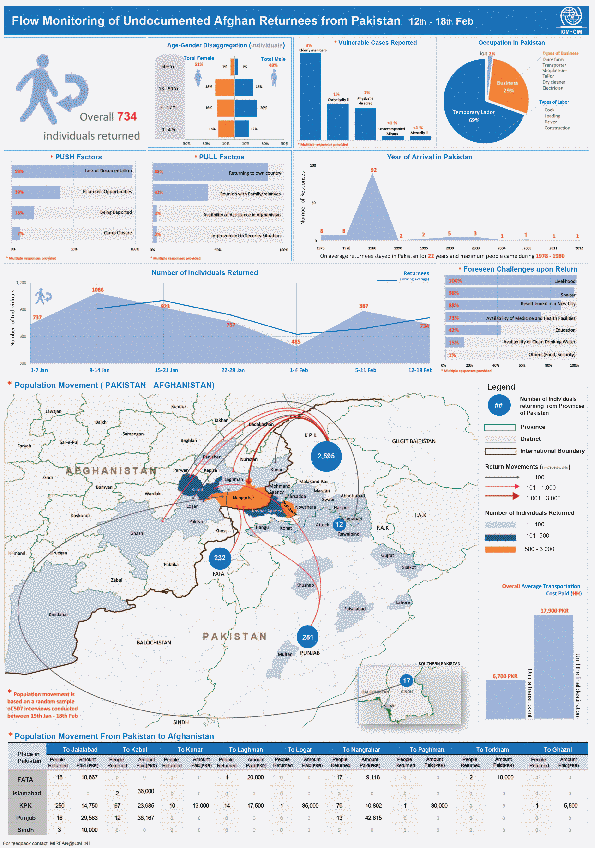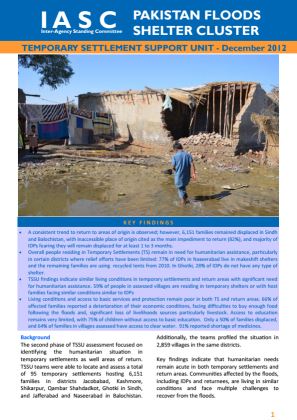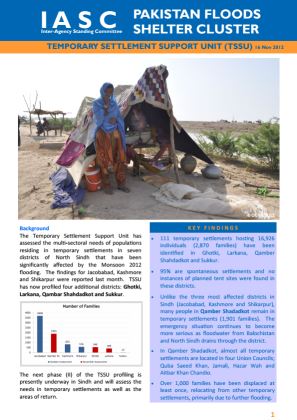-
Countries
-
Data and Analysis
-
Special Focus
-
Crisis Responses
Pakistan
Pakistan
TDPs tracked
Displacement Movements
23,000
IDMC 2023
Data collection round
About Pakistan
In 2010, IOM’s Displacement Tracking Matrix (DTM) programme started its activities in Pakistan as part of IOM’s emergency flood response programme. Over the years, DTM has evolved into a comprehensive programme covering a wide range of activities. The DTM programme works closely together with a wide array of stakeholders, including government ministries and national and sub-national statistical organizations, UN agencies, and specialized research institutes. Its activities are instrumental in providing stakeholders with an evidence-base to effectively address humanitarian, transition, and development needs within the country.
In 2017, DTM started the implementation of its Flow Monitoring (FM) activities. DTM collects FM data at the Torkham (Khyber Pakthunkhwa), Chaman, Badini and Bahramcha (Balochistan) border crossing points (BCPs) to identify cross-mobility patterns and profiles of Afghans who are returning from Pakistan to Afghanistan. The data presented in FM information products is harmonized with those from the United Nations High Commissioner for Refugees (UNHCR), who also cover Ghulam Khan (Khyber Pakhtunkhwa). DTM Pakistan also actively coordinates its data collection efforts with the DTM programme in Afghanistan.
As part of the 2022 flood response, DTM launched mobility tracking operations in flood-affected settlements or settlements that hosted temporary displaced persons (TDPs) across 11 districts in Balochistan and Sindh to provide partners with timely information on the displacement situation. Since then, DTM’s mobility tracking has expanded to cover 30 districts across three provinces (Balochistan, Sindh and Khyber Pakhtunkhwa) and collects information on the multisectoral needs and recovery needs at the settlement level, in addition to the displacement situation.
In May 2023, DTM scaled-up its mobility tracking efforts to support the ongoing response efforts for Afghans in Pakistan. DTM’s Afghan response has been implemented in 33 districts across Balochistan, Khyber Pakhtunkhwa, Islamabad, Punjab, and Sindh, and aims to provide stakeholders with up-to-date information on the multisectoral needs of Afghans in the country.
Furthermore, under the European funded project “Displacement Tracking Matrix Regional Evidence for Migration Analysis and Policy (DTM REMAP), from 2019 to 2022, DTM implemented two household surveys. The first survey was the survey on Drivers of Migration (SDM) which aimed at better understanding the drivers of Pakistani international out-migration. The second survey was the “Returnee Longitudinal Survey (RLS)”. The purpose of RLS was to improve understanding of return migrants’ profiles, vulnerabilities and needs, as well as sustainable return and reintegration outcomes in the short- and medium-term.
Contact
DTM Pakistan
DTMPakistan@iom.int
Current Donors
- EU-INTPA
- ECHO
- Ministry of Foreign Affairs of Italy
- PRM
- Canada – IRCC
- Canada (DFATD)
- Netherlands
Pakistan — Flow Monitoring of Undocumented Afghan Returnees from Pakistan (30 July — 5 August 2017)
905 Undocumented Afghan individuals returned to Afghanistan through the Torkham border crossing whilst 1,048 individuals used the Chaman/Spin Boldak border crossing, bringing the total number of returns this week to 1,953 (323 families).
Pakistan — Flow Monitoring of Undocumented Afghan Returnees from Pakistan (23—29 July 2017)
During the reporting period 1,798 undocumented Afghan returnees were identified through Torkham and Chaman/Spin Boldak. Thus far in 2017 78,664 Afghan returneed have been identified through the above-mentioned locations.
Pakistan – Flow Monitoring of Undocumented Afghan Returnees from Pakistan (16 — 22 July 2017)
846 Undocumented Afghan individuals returned to Afghanistan through the Torkham border crossing whilst 1,117 individuals used the Chaman/Spin Boldak border crossing, bringing the total number of returns this week to 1,963 (315 families).
Pakistan – Flow Monitoring of Undocumented Afghan Returnees from Pakistan (9—15 July 2017)
1,172 Undocumented Afghan individuals returned to Afghanistan through the Torkham border crossing whilst 982 individuals used the Chaman/Spin Boldak border crossing, bringing the total number of returns this week to 2,154 (337 families).
Pakistan – Flow Monitoring of Undocumented Afghan Returnees from Pakistan (18 June — 1 July 2017)
The overall returnees through Torkham and Chaman during this reporting period were 852 individuals. Of these 51% were female and 49% were male. 44% were between 5 and 17 years old. 38% were between 18 and 59 years old.
Pakistan – Flow Monitoring of Undocumented Afghan Returnees from Pakistan (11—17 June 2017)
During the reporting period, DTM identified a total of 644 undocumented Afghans who had returned from Pakistan through the Torkham border. DTM has identified 69,912 returnees since January 2017.
Pakistan — Return of Undocumented Afghans from Pakistan (4—10 June 2017)
During the reporting period, DTM identified a total of 1,004 undocumented Afghans who had returned from Pakistan through the Torkham border. DTM has identified 69,268 returnees since January 2017.
Pakistan — Flow Monitoring Return of Undocumented Afghans from Pakistan (28 May — 3 June 2017)
DTM identified 685 undocumented Afghans returning from pakistan through Torkham during this reporting period.
Pakistan — Return of Undocumented Afghans from Pakistan (21—27 May 2017)
During the reporting period, DTM identified a total of 5,062 undocumented Afghans who had returned from Pakistan through the Torkham border. DTM has identified 48,984 returnees since January 2017.
Pakistan — Return of Undocumented Afghans from Pakistan (14 — 20 May 2017)
Durning this reporting period DTM indentified 4,535 undocumented Afghan returnees through Torkham. Of the total identified population 51% are female and 49% are male.
Pakistan — Flow Monitoring of Undocumented Afghan Returnees from Pakistan (23 – 29 April 2017)
DTM recorded 29,278 returnees since January 2017. The report further details age and gender disaggregation, recorded vulnerable cases, information on households travelling with assets to Afghanistan, push and pull factor trends and movement trends and transportation costs.
Pakistan — Flow Monitoring of Undocumented Afghan Returnees from Pakistan (7—13 May 2017)
IOM Pakistan’s Weekly Situation Report on the Return of Undocumented Afghans through the Torkham border during the reporting period of 7th - 13th May 2017.
Pakistan — Flow Monitoring of Undocumented Afghan Returnees from Pakistan (30 April —6 May 2017)
IOM Pakistan’s Weekly Situation Report on the Return of Undocumented Afghans through the Torkham border during the reporting period 30th April - 6th May 2017.
Pakistan — Flow Monitoring of Undocumented Afghan Returnees from Pakistan (23—29 April 2017)
IOM Pakistan’s Weekly Situation Report on the Return of Undocumented Afghans through the Torkham border during the reporting period of 23rd – 29th April 2017.
Pakistan — Flow Monitoring of Undocumented Afghan Returnees from Pakistan (16—22 April 2017)
IOM Pakistan’s Weekly Situation Report on the Return of Undocumented Afghans through the Torkham border, reporting period [16th - 22th April 2017].
Pakistan — Flow Monitoring of Undocumented Afghan Returnees from Pakistan (9- 15 April 2017)
IOM Pakistan’s Weekly Situation Report on the Return of Undocumented Afghans through the Torkham border, reporting period [9th - 15th April 2017].
Pakistan — Flow Monitoring of Undocumented Afghan Returnees from Pakistan (2—8 April 2017)
IOM Pakistan’s Weekly Situation Report on the Return of Undocumented Afghans through the Torkham border, reporting period [2nd - 8th April 2017].
Pakistan — Flow Monitoring of Undocumented Afghan Returnees from Pakistan (26 March —1 April 2017)
IOM Pakistan’s Weekly Situation Report on the Returns of Undocumented Afghans through the Torkham border, reporting period [26th March - 1st April 2017].
Pakistan — Flow Monitoring of Undocumented Afghan Returnees from Pakistan (19—25 March 2017)
During the week of 19th – 25th March 2017, a total of 869 (143 families) undocumented Afghans returned from Pakistan through the Torkham border. Movement trends for the reporting period indicate: Of the total, 62%
Return Intentions of Afghan Returnees in Pakistan (6—10 February 2017)
The surveys informing this report were carried out in two districts of Khyber Pakhtunkhwa (KP), namely Peshawar and Haripur, during the 6th and 10th of February 2017. A total of 279 individuals in 42 families were surveyed. Four Focus Group Discussions were also carried out in both districts.
Pakistan — Flow Monitoring of Undocumented Afghan Returnees from Pakistan (12—18 February 2017)
During the week of 12-18 February 2017, a total of 734 (154 families) undocumented Afghans returned from Pakistan through the Torkham border.
Pakistan — Migration Flows from Afghanistan and Pakistan to Europe Desk Review Report (August 2017)
This desk review report is the output of the first phase of IOM’s project implementation on data collection to enable a better understanding of migration flows from Afghanistan and Pakistan towards Europe.
Pakistan — Floods 2012 TSSU Report (December 2012)
A consistent trend to return to areas of origin is observed; however, 6,151 families remained displaced in Sindh and Balochistan, with inaccessible place of origin cited as the main impediment to return (82%), and majority of IDPs fearing they will remain displaced for at least 1 to 3 months.
Pakistan — Floods 2012 TSSU Report (November 2012)
111 temporary settlements hosting 16,926 individuals (2,870 families) have been identified in Ghotki, Larkana, Qamber Shahdadkot and Sukkur. 95% are spontaneous settlements and no instances of planned tent sites were found in these districts.







